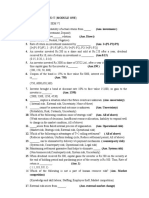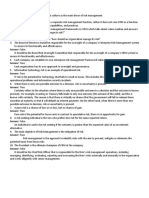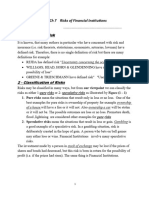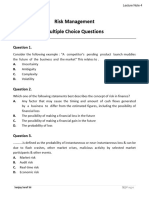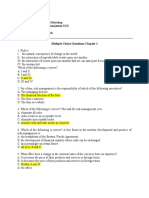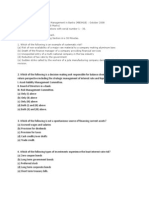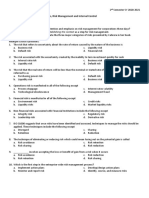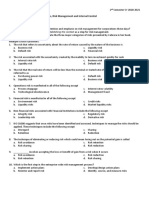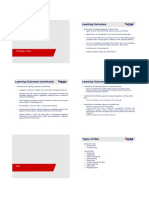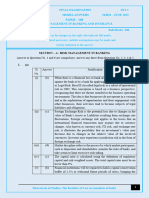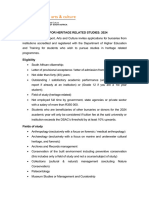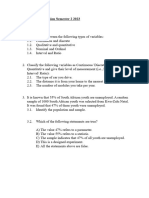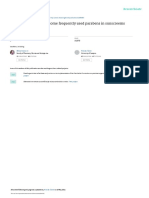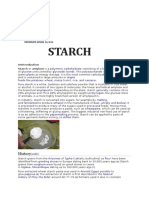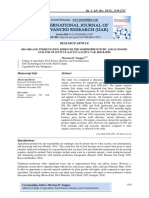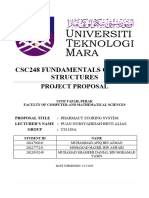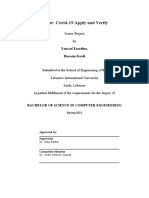FINA312: FINANCIAL RISK MANAGEMENT
TUTORIAL 1 - QUESTIONS
TOPIC 1: RISK, RISK MANAGEMENT, REGULATION AND
ETHICS
SECTION A: MULTIPLE-CHOICE QUESTIONS
1. Good risk management practices in an organization should: (I) focus on enterprise risk
management (II) provide for the appointment of a chief risk officer (III) provide for a
risk management committee (IV) give clear guidance to management (V) not
encompass the entire company and filter down from senior management to all
employees.
A. Only (I), (II), and (IV) are correct.
B. Only (II), (III), and (IV) are correct.
C. (I), (II), (III), and (IV) are correct.
D. Only (I), (II), and (V) are correct
E. (I), (II), (III), (IV) and (V) are correct.
2. A maize farmer from Umhlanga is worried that maize prices will be lower than expected
when his maize will be ready for sale, hence, he has entered into a contract to sell his
maize in three-months’ time. The parties agreed on a specified quantity at a specified
price and a specific future date for delivery. Which of the following is most likely the
primary purpose of the farmer to arrange this trade?
A. to manage compliance risk
B. to trade on information
C. to save money for the future
D. to manage operational risk
E. to manage commodity price risk
3. Which of the following is false concerning risk?
A. Risk is the effect of uncertain future events on a company or on the outcomes the
company achieves.
B. Risk results in adverse outcomes; adverse in relation to planned objectives or
expectations.
C. Risk results in an adverse variation of profitability or outright losses.
D. Risk is eliminated by implementing a risk management process.
E. Risk arises out of uncertainty.
Page 1 of 6
�4. Nick Leeson’s rogue trading activities resulted in Barings Bank losing approximately
£827 million. Rogue trading is best described as an example of:
A. investment risk.
B. operational risk.
C. compliance risk.
D. liquidity risk.
E. credit risk.
5. SAA-19 a regional airline, receives 80% of its revenues in South African Rands (ZAR)
and the remainder in United States Dollars (USD). The airline pilots have been on strike
for three months but SAA-19 has an obligation to continue to make lease payments on its
fleet. What is the primary risk faced by SAA-19?
A. Credit risk
B. Liquidity risk
C. Interest rate risk
D. Equity price risk
E. Currency risk
6. Due to the COVID-19 pandemic, Mluleki Jones is evaluating the potential impact of
changes in the economy and healthcare conditions on Medi-Corp, a firm in the
pharmaceutical business. Medi-Corp’s uncertainty with respect to the price of drugs
produced is referred to as:
A. compliance risk
B. market risk
C. operational risk
D. interest rate risk
E. settlement risk
7. A significant benefit of implementing a risk management process is most likely:
A. the elimination of risk.
B. less accountability.
C. the more efficient allocation of capital.
D. more effective processes and less accountability.
E. the elimination of risk and less accountability.
8. Which one of the following is not a source of operational risk?
A. Execution, delivery, and process management.
B. Model misspecification.
C. Business disruption and systems failure.
D. Employment practices and workplace safety.
Page 2 of 6
�9. The recent COVID-19 pandemic induced uncertainty among investors in the stock
market. This lead to a reduction in trading activity making it difficult to buy and sell stocks.
Identify the main type of risk that this scenario represents.
A. Equity price risk.
B. Credit risk.
C. Asset liquidity risk.
D. Funding liquidity risk.
E. Market risk.
10. South Africa is currently experiencing a serious energy crisis which has widespread
effects on businesses and the economy at large. This “load shedding” or energy crisis
exposes businesses to which type of risk?
A. Credit risk
B. Liquidity risk
C. Operational risk
D. Model risk
11. Which of the following is known as the third pillar of the Basel II accord?
a) Minimum capital requirement
b) Supervisory review process
c) Standard approach
d) Market discipline
12. Which one is not under the three pillars of Basel II norms in the banking industry?
a) Market Discipline
b) Minimum Capital Requirement
c) Risk oriented Supervision
d) Supervisory Review Process
13. To calculate the capital adequacy ratio, the banks are required to take into account which
of the following risks?
a) Credit risk and operational risk
b) Credit risk and market risk
c) Market risk and operational risk
d) Credit risk, market risk, operational risk
14. Which type of risk is the focus of Basel I?
a. Operation Risk
b. Credit Risk
c. Market Risk
d. All of the above
Page 3 of 6
�15. Banks maintain a cushion of capital that can be drawn at the time of losses or stress is
known as ___________.
a. Capital Conservation Buffer
b. Country Cyclical Buffer
c. Net Stable Funding
d. None of these
Page 4 of 6
�SECTION B: SHORT QUESTIONS
Part A:
The following extract is obtained from an article published by RSM International Ltd. titled
“The business risks in post-pandemic Africa: Unstable financial markets”.
Odirile Setlhoka, RSM Botswana, suggests that for middle market businesses, “Instability
within financial markets is posing myriad challenges, including the impact from inflation,
liquidity issues, rising interest rates, and access to credit due to reduced lending. All of these
present risks for business investors. Further risks come from potential repatriation of profits,
with some countries in Africa having rather tight tax laws, especially on withdrawal of profits
or payment of dividends to foreign shareholders.
“Rigorous evaluation in financial planning is vital in mitigating the risks of financial
instability, with liquidity issues being a key point of focus. Post pandemic, most companies
in Botswana are looking to raise capital to finance the recovery of their business operations.
Their first objective is to manage liquidity to ensure that there is enough cash available to
fund the day-to-day operations and ongoing business activities.
“Given the uncertainty created by COVID, improvement of working capital management is
important, especially the accelerated collection of debts. Restructuring of the balance sheet
may also be important in conserving cash. Businesses with robust working capital
management practices and a strong cash position will likely receive a warm reception from
lenders.”
In Eswatini, Mphile Manana says, “Just as the economy was starting to make a rebound from
the effects of the pandemic, the Russian war in Ukraine has become another factor impacting
the growth of economies. A surge in global oil prices has resulted in an increase in fuel prices
which in turn has led to an increase in prices of inputs and food.
“Our currencies have been taking a beating as they are depreciating against the major
currencies and this has resulted in an increase in the cost of imported supplies and inputs.
Inflation has also increased which in turn has led to an increase in the cost of borrowing as
commercial banks increase lending rates.”
Based on the information provided, identify and explain the different types of risks that
impact investors or companies in Africa in the post-pandemic era. In addition, you are also
required to provide practical guidance to investors or companies on how each of the
identified financial risks can be managed.
Page 5 of 6
�Part B:
Briefly discuss the implementation of Basel II and Basel III in South Africa.
Page 6 of 6


